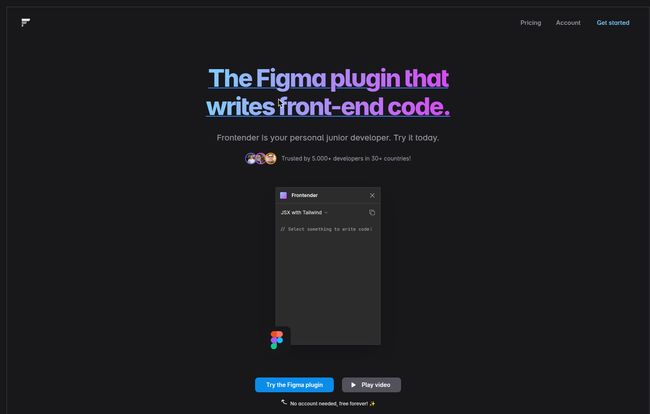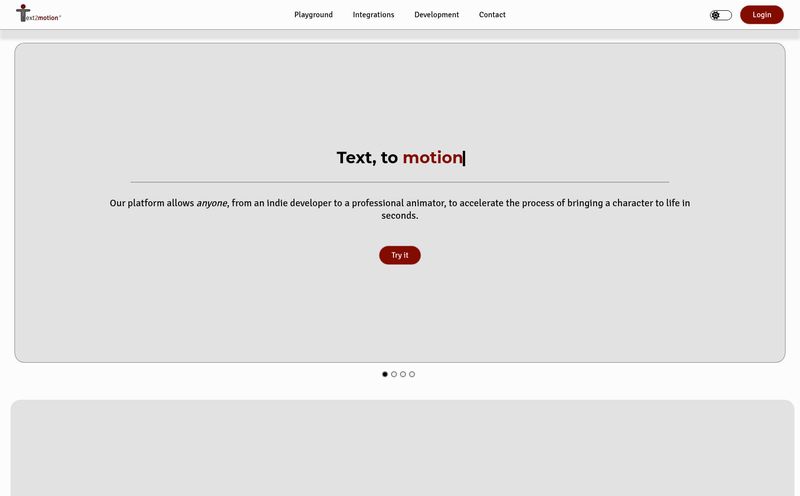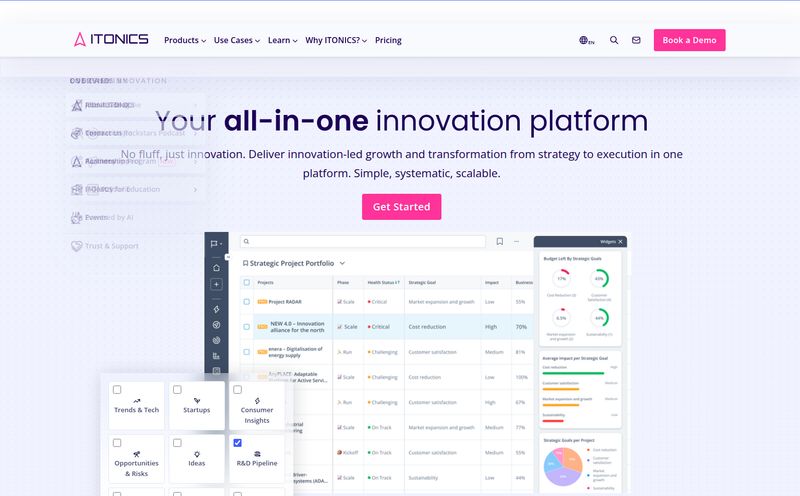You and me. As someone who’s been neck-deep in the SEO and dev world for years, I've seen my fair share of “game-changing” tools. Most of them promise to revolutionize your workflow, but end up just adding another subscription to your monthly bill and a fresh layer of complexity you didn't ask for. So when I first heard about Frontender, a Figma plugin that claims to be my “personal junior developer,” my skepticism-meter went off the charts.
Another Figma-to-code tool? Groundbreaking. I’ve seen them before. They usually choke on anything more complex than a button, demand perfectly organized auto-layouts, and spit out a mess of nested divs that would make a 2005-era developer blush. But... the buzz around this one felt a little different. So, I grabbed a coffee, installed the plugin, and decided to see if it was just another flash in the pan.
So What Is Frontender, Really?
In a nutshell, Frontender is a plugin that lives inside Figma. You select a design element—a component, a section, a whole page—and it converts that visual design into actual, usable front-end code. We're not just talking about one flavor of code, either. It’s pretty versatile, offering outputs like:
- Good old fashioned HTML with CSS
- HTML with Tailwind CSS
- JSX with CSS-in-JS
- JSX with Tailwind CSS
It also plays nice with the big frameworks we all know and love (or love to complain about), including Next.js, React, Vue, and even Svelte. The idea is to bridge that massive, time-sucking gap between a beautiful, static design in Figma and a living, breathing component in your codebase. It’s not meant to replace you, but to act as a tireless assistant that handles the initial, often tedious, scaffolding.
The One Feature That Made Me Look Twice
Here’s what really got me. The landing page says it “Works with any Figma file.” Yeah, right, I thought. I’ve heard that before. Most of these tools require you to become a Figma-autolayout-guru, structuring your layers with the precision of a Swiss watchmaker. If one thing is out of place, the whole conversion collapses into chaos.
But Frontender seems to have a different philosophy. It claims to be smart enough to figure out layouts even if they're not perfectly organized. It looks at positioning, order, and styling to make an educated guess. This is huge. I mean, how many of us have inherited a Figma file that looks like a digital Jackson Pollock painting under the hood? Or worked with a designer who is brilliant visually but couldn't care less about layer organization? It happens. All the time. A tool that can make sense of that creative chaos is, in my book, a tool built for the real world, not a textbook.

Visit Frontender
It’s like having a junior dev who doesn’t need constant hand-holding. You can just point them to a messy mockup and say, “make this,” and they actually come back with something decent. That’s the dream, isn't it?
Does It Write Code or Just... Code-Like Suggestions?
This is where the rubber meets the road. Generating code is easy; generating good code is hard. From what I’ve seen, Frontender does a surprisingly clean job. The HTML structure is logical, and the CSS is straightforward. But the real star for me is the Tailwind CSS support.
I’m a big Tailwind fan. It’s transformed how I build UIs. Frontender doesn’t just generate generic Tailwind classes; it can work with your project's `tailwind.config.js` file. You can point it to your custom theme—your specific colors, spacing units, and font sizes—and it will generate code using your design system's tokens. It will find the closest value in your config, so you're not getting rogue `#2E3B4E` hex codes when you should be using `theme('colors.slate.800')`. This is incredibly powerful for maintaining consistency and not having to refactor every single thing the tool produces.
"Being a front-end developer, I must say this plugin is the greatest I’ve ever seen." - Mian Awan
That quote from their site feels a bit strong, but I get the sentiment. It solves a real, nagging problem.
Let's Talk Money: The Frontender Price Tag
Alright, nothing good in life is free, right? Well, mostly. Frontender operates on a freemium model, which I appreciate. You can dip your toes in without opening your wallet. Here’s the breakdown as of writing this:
| Plan | Price | Key Feature |
|---|---|---|
| Free | SGD 0 | 15 free conversions per month. |
| Professional (Monthly) | ~SGD 14.81 / month | Unlimited conversions & all pro features. |
| Professional (Annual) | ~SGD 11.10 / month (billed annually) | Best value, effectively getting 3 months free. |
Note: Prices are in Singapore Dollars (SGD) and might fluctuate. They also had a "2025 summer sale" advertised, so keep an eye out for discounts!
The free plan with 15 conversions is perfect for small personal projects or just for giving the tool a proper test drive. For any serious professional or agency work, you'll hit that limit pretty fast. The Professional plan, especially the annual one, seems reasonably priced if this tool genuinely saves you even a few hours a month. And let's be honest, it probably will.
The Good, The Bad, and The Code-y
No tool is perfect. After my initial excitement, I tried to look at Frontender with a more critical eye. On the one hand, the speed and accuracy are a massive win. The ability to just grab a messy design and get 80% of the way to a finished component in seconds is a huge boost to productivity. The support for modern frameworks and especially the deep Tailwind integration are major selling points.
On the other hand, its greatest strength is tied to a paid subscription. The most powerful features, like unlimited conversions and that instant code generation, are locked behind the Professional tier. The free plan is more of a demo than a long-term solution for a working developer. This isn't really a 'con' so much as a business model, but its something to be aware of. You have to be willing to invest to get the full benefit.
Who Is This Really For?
I’ve been mulling this over. I don't think Frontender is for absolute beginners who don't know any code. The output still requires a developer's eye to integrate, tweak, and make fully functional. Instead, I see it being a perfect fit for a few groups:
- Frontend Developers: To obliterate the time spent on mind-numbing boilerplate. Use it to scaffold components, then spend your valuable time on logic and interaction.
- Full-Stack Developers: For those of us who are more comfortable in the backend and find CSS a bit of a dark art, this can be a lifesaver for getting a UI off the ground quickly.
- Digital Agencies: The faster you can turn a design into a working prototype or a final product, the better your margins. This seems like a no-brainer for agency environments.
- Designers Who Code: If you're a designer who can sling some code, this will help you bring your own visions to life without getting bogged down in the syntax.
Your Frontender Questions Answered
Can Frontender handle complex, nested components?
Yes, that's one of its main strengths. You can select a large frame with multiple nested elements, and it will attempt to replicate the entire structure in code. The quality of the output will, of course, depend on the clarity of the design, but it’s built to handle more than just simple buttons.
Is the generated code truly production-ready?
I’d call it “scaffold-ready.” It’s clean, semantic, and a fantastic starting point. You will almost always need to review it, add your state management, event handlers, and other logic. It writes the HTML and CSS for you; it doesn't write the application itself.
How does it compare to other tools like Anima or Locofy?
This is a great question. While they all play in the same sandbox, Frontender’s focus on working with messy files and its deep, customizable Tailwind integration feel like key differentiators. Some competitors are more focused on creating high-fidelity prototypes, while Frontender seems more squarely aimed at generating clean code for a developer to immediately use in their editor.
Does the Tailwind CSS feature work with any `tailwind.config.js`?
Yes, that's the beauty of it. You can provide your custom configuration, and it will use your defined theme (colors, spacing, fonts, etc.) to generate the classes. This is crucial for maintaining design system consistency.
What happens when I run out of my 15 free conversions?
Once you've used your 15 conversions for the month on the free plan, you'll have to wait until the next month for them to reset, or upgrade to a Professional plan for unlimited conversions.
Is it difficult to install and use?
Not at all. It's a Figma plugin, so you just find it in the Figma Community, click install, and you're good to go. The interface within Figma is straightforward: select your object, choose your output format, and copy the code.
So, is Frontender the Junior Dev You Should Hire?
After spending some real time with it, my initial skepticism has faded. Frontender isn't going to put front-end developers out of a job. It's not sentient. But calling it a “personal junior developer” isn’t just marketing fluff; it’s a surprisingly accurate metaphor. It does the grunt work. It takes the design, translates it diligently, and hands you a clean file to start building on. It frees up your senior-level brain to focus on the hard problems: accessibility, performance, state management, and all the things that truly make a great user experience.
It's an accelerator, a force multiplier. For the price of a few fancy coffees a month, it promises to save you hours of tedious work. And in my experience, that's an investment that pays for itself almost immediately. Give the free version a shot—what have you got to lose?



